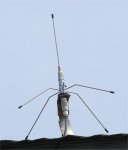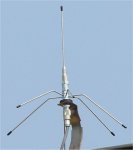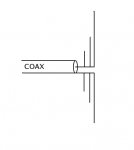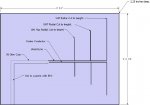Slip - Very nice antenna, but are the ground radials attached to th shield of the coax or to the center conductor? That looks like a 3/8x24 thread CB style antenna mount with the radials attached to the little spacer that goes between the mount and the antenna threads..is that how that is built?
AI42 - I'm not argueing with you, I'm just pointing out that since he most likely isn't a communications specialist and probably doesent have all the gear needed to design and impliment a perfect antenna system that a comprimise antenna system will work in his case. While using a single antenna resonate at the bands he wants to receive would be better than using 2 seprate antennas, 2 seprate antennas will work for what he needs to do. I am also pointing out that building an antenna system for 2 specific bands will usually perform better than trying to use a commercially produced scanner antenna. The important thing here is that he wants to receive low band FM and UHF FM and i seriously doubt he is trying to hear weak signal UHF CW EME from the other side of the planet, and in all practicality with a scanner being able to gain that extra percent of signal is probably not going to make much of a difference, but in the rare case it will. As for spacing the antennas that far apart I would fully expect multipathing, and if he lives in an area where there are tall buildings and mountains and other large objects for the signal to reflect off of i would also expect multipathing. Remember, this is only a scanner antenna we are talking about, not an uber-god antenna to hear the Mars rovers. he wanted to build an antenna, so we have provided the information for him to build an antenna and provided him the information needed to do such. You know as well as I that when telling someone how to design and build an antenna system who has never done it before, you start with the basics and leave the insanely technical aspects for another time, otherwise people get confused because there are a lot of gaps as to teh whys and hows that are missing in between. I'm not going to nit pick details over a simple scanner antenna project, I know that using multiple antennas on one receiver for several different bands will have problems, but in general the listener will never notice the effects because the problems created are so insignificant when doing recreational radio monitoring that you cant tell. Now if he was all about doing insanely technical monitoring with a $10k service monitor, then we could work out the details for a optimized single antenna or antenna system. Anyway, back to the thread at hand and we can save the super-technical stuff for when someone wants to hear 1296MHz CW EME






